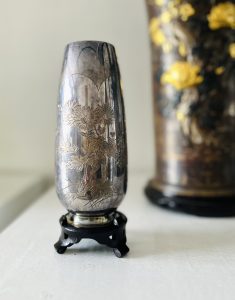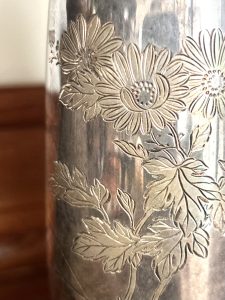銀製品、涼やかさだけではありませんでした(愛知県名古屋市千種区姫池通 骨董買取 古美術風光舎)
2024.07.15
皆さまこんにちは。スタッフHでございます。
夏の蒸し暑さの中、店内のガラス製品や銀製品の涼やかさが目を引きます。

銀製品は涼やかさだけではなく、近年の研究では脱臭や抗菌効果が期待されるとして様々な製品に使われています。
銀を水に入れ電流を流すと電気分解され銀イオンが発生し、その銀イオンは細菌に付着し、細菌の生命維持に必要な酵素の働きを止めてしまいます。そのため銀イオンを含んだ水で洗濯をすると銀イオンが繊維の中に入り込み細菌の繁殖を抑え、防臭効果も高めてくれるとされています。
古くから銀は宝飾品、食器などに使われてきましたが、少し恐ろしいお話として。中世では毒物にヒ素が多く使用されており、当時の純度の低いヒ素には硫黄が含まれていて、硫黄に反応して黒く変色する銀の食器が毒殺から身を守るものとして使われていたという説もあります。
人と長い付き合いのある銀ですが、その起源はどのようなものだったのでしょうか。その歴史を調べてみました。
最も古い歴史としては紀元前4000年頃にアナトリア半島カッパドキア(現トルコ中部)で粒状の銀がつくられたと言われています。
最古の銀製の宝飾品は紀元前3000年頃、古代シュメールの都市ウルの埋葬遺跡で銀を素材にしてつくられたものが発見されています。中世の時代には重要な装飾品を作るために銀が活用されていました。
当時は銀は自然銀でも産出しましたが、自然金よりは少なく鉱石から取り出す必要があり、技術的に金よりも銀の方が純度の高いものを手にするのが難しかったため、純度の高い銀は非常に貴重で、金の2.5倍の価値があったともいわれています。
紀元前2500年頃、銀を精錬する灰吹法が発明され銀の生産量が一気に増え、銀の価値は金に比べ低いものとなっていきました。
灰吹法とは金や銀を含んだ鉱石と鉛を混合して加熱し合金を作ります。それを灰が入っている皿の灰の上に置き加熱すると、鉛は酸化して溶けて酸化銀となり灰の中に染み込み、不純物の少ない金や銀が灰の上に残るという精錬方法です。
大量に生産できるようになった銀からは銀貨が作られるようになり、最も古い銀貨は紀元前650年ころリディア王国で作られたとされ、その後ギリシャでも鋳造されるようになりました。採掘には多くの奴隷を苦役があったそうです。多くの犠牲もあったのでしょうね。
15世紀終わりから、ポルトガルとスペインによる新航路の開拓が進み、16世紀には地球上の大陸や海域は船によって繋がり世界の一体化が始まりました。コロンブスの大西洋横断から約50年後、スペイン支配下の南米アンデス山中でも銀鉱が発見され銀が大量生産され世界へと広まりました。
日本でも1530年代に灰吹法が導入され、石見銀山を中心とした日本銀の産出が増大し、一転して銀の輸入国から輸出国となりました。
日本とアメリカ大陸での銀の大量生産により、銀は国際商品としてこの時期の貿易の拡大を支えたのといわれています。
その頃の中国では銀に対する需要が高まっており、当時貴重なものとされていた中国の絹織物や陶磁器などが銀と交換され大量にヨーロッパへ流れたといわれています。
大航海時代に貿易の中心となった銀は、日用品や芸術品などに形を変え現在の生活を彩っています。
次回は様々な銀製品について綴ってみようと思います。
それでは、また次の機会に。

Hello everyone. This is Staff H.
In the humid summer heat and humidity, the coolness of glass and silver products in the store catches my attention.
Silver products are not only cool but also used in various products as they are expected to have deodorizing and antibacterial effects according to recent studies.
When silver is put in water and an electric current is applied, it is electrolyzed to produce silver ions, which adhere to bacteria and stop the action of enzymes that are necessary for bacteria to maintain life. Therefore, when washing clothes in water containing silver ions, the silver ions penetrate into the fibers, inhibit the growth of bacteria, and enhance the deodorant effect.
It has been used for silver coins, jewelry, and tableware since ancient times. A somewhat frightening story is that arsenic was widely used as a poison in the Middle Ages, and there is a theory that silver tableware, which reacts with sulfur and turns black in response to sulfur, was used as protection against poisoning because the low-purity arsenic of the time contained sulfur.
Silver has a long association with people, but what were its origins? We looked into its history.
The earliest known history of granulated silver is said to date back to around 4000 B.C. in Cappadocia on the Anatolian Peninsula (now in central Turkey).
The oldest silver jewelry was found around 3000 B.C., made of silver at the burial site of the ancient Sumerian city of Ur. During the Middle Ages, silver was used to make important ornaments.
At that time, silver was also produced as natural silver, but it had to be extracted from ore less than natural gold, and since it was technically more difficult to obtain silver of higher purity than gold, silver of higher purity was extremely valuable and was said to be worth 2.5 times as much as gold.
Around 2500 B.C., the ash-blowing method of refining silver was invented, and silver production increased dramatically, making silver less valuable than gold.
In the ash-blowing process, ores containing gold or silver are mixed with lead and heated to produce an alloy. The lead oxidizes and melts to silver oxide, which seeps into the ash, leaving the gold and silver with few impurities on top of the ash.
The earliest silver coins were made in the Kingdom of Lydia around 650 B.C., and were later minted in Greece. Mining required the hard labor of many slaves. There must have been a lot of sacrifices.
From the end of the 15th century, Portugal and Spain began to explore new sea routes, and by the 16th century, the continents and seas of the earth were connected by ships, beginning the unification of the world. About 50 years after Columbus’ Atlantic crossing, silver ore was discovered in the Andes mountains of South America under Spanish rule, and silver was mass-produced and spread throughout the world.
In Japan, the ash-blowing method was introduced in the 1530s, and the production of Japanese silver, mainly from the Iwami Ginzan Silver Mine, increased, turning Japan from a silver importer to an exporter.
The mass production of silver in Japan and the Americas is said to have supported the expansion of trade in silver as an international commodity during this period.
At that time, demand for silver was increasing in China, and Chinese silk fabrics and ceramics, which were considered valuable at the time, were exchanged for silver and shipped in large quantities to Europe.
Silver, which became the center of trade during the Age of Discovery, has been transformed into daily necessities and works of art, and is now a part of our daily lives.
In my next entry, I will write about various silver articles.
See you next time.
*******************
ご実家の整理やお片付けなどをされている方のご相談などが多くございます。
お片付けなどくれぐれもご無理のないようになさってくださいませ。
風光舎では古美術品や骨董品の他にも絵画や宝石、趣味のお品など様々なジャンルのものを買受しております。
お片付けをされていて、こういうものでもいいのかしらと迷われているものでも、どうぞお気軽にご相談下さいませ。
また風光舎は、出張買取も強化しております。ご近所はもちろん、愛知県内、岐阜県、三重県その他の県へも出張いたします。
まずは、お電話お待ちしております。
愛知県名古屋市千種区姫池通
骨董 買取【古美術 風光舎 名古屋店】
TEL052(734)8444
10:00-18:00 OPEN

